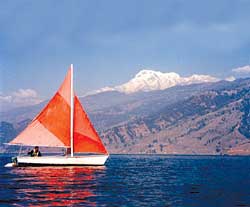 Fears of pre-poll violence, the emergency, an international slump in air travel post-September 11 and fears of India-Pakistan tensions continue to keep tourists away from Nepal. Booking for the autumn season are down, and cancellations are coming in.
Fears of pre-poll violence, the emergency, an international slump in air travel post-September 11 and fears of India-Pakistan tensions continue to keep tourists away from Nepal. Booking for the autumn season are down, and cancellations are coming in. Althogh it is picking up again in southeast Asia, tourism shows no signs of recovery here. Nepal Tourism Board (NTB) has tried to put on a brave face by saying that arrivals are up 35 percent this July compared to July 2001. But that is misleading because last July saw a serious post-royal massacre slump.

Saskia is a Dutch tourist who was all set to travel to India and Nepal this autumn. But on advice of the Dutch government, she's decided to postpone her plans to visit the region. Lina is a Swede, but she has decided to defy her government's travel alert for Nepal and is coming for a trek in October. On Thursday, the US embassy upgraded its travel advisory for Nepal in lieu of the 16 September Maoist strike saying Americans and other tourists could be at risk.
"Traffic to Nepal has been affected by travel advisories issued by the US, Britain and many European countries deterring travel to India," NTB says. Still, the promotional body says Indian arrivals are double last year's figures, and there have been dramatic increases from Australia and Japan. But the downturn for the main markets-Britain, the US, Germany and France-continues.
"The unrest in Afghanistan, India-Pakistan tension and Nepal's own internal problems have impacted heavily on tourism. Things don't look too encouraging," says Suman Pandey, President of the Trekking Agents Association of Nepal (TAAN).
Nepal was voted the second "top travel destination" in May this year, ranking after New Zealand in a survey by the Guardian newspaper in London. The accolade came six months after Nepal was voted second in the Top Country Category out of 180 countries in the Wanderlust Travel Awards 2001. But such distinction does not show in arrival figures.
Trekking agencies members in Kathmandu say there have been a lot of cancellations, and this seems to be related to fears of violence preceding the November polls. "We have tried to tell our clients that the Maoists are not targeting trekkers, but there is a perception of insecurity for the coming season," said another trekking agent who had cancellations by three groups one morning this week.
Hotel Association of Nepal president, Narendra Bajracharya, is just back from a promotion trip to Thailand, Singapore and Malaysia. "Southeast Asia is seeing a revival, but we are looking at an average of only 20 percent occupancy," he told us.
For S P Koirala, at the Ministry of Culture Tourism and Civil Aviation, it is clear what needs to be done: "We first need to put our house in order." Koirala is optimistic that the government's recent decisions to open up new trekking areas and climbing peaks, streamlined mountaineering rules, lowering of visa fees and the addition of the Chinese market will ensure a swift recovery once a tourism turnaround take
One sector of tourism that remains relatively unaffected is mountaineering. "Going by the trends this spring, the numbers have remained more or less constant. While there were a few teams on the newly opened peaks, we've had many enquires," Ganesh Raj Karki at the Tourism Department's Climbing Section told us.
More than 20 expeditions are expected to scale Mt Everest from the Nepali side next spring to mark the 50th anniversary of the first ascent. Tourism entrepreneurs say they don't have their hands folded. Says Pandey: "We've got to keep Nepal alive in the market, we've got to remind people that we're still in the running, that we've started a recovery process."
NTB has launched a "Destination Nepal Campaign 2002-2003" but for that to show results, everyone agrees there has to be a change in the ground situation at home. Tourism entrepreneurs in Manang have got together with the Annapurna Conservation Area Project to promote Destination Manang 2004 in the hope of boosting the local economy. If things work out, and Nepal's security situation improves, the prediction by the Pacific Area Travel Association (PATA) of a revival in travel trends in the region may well come true. Fingers crossed.


